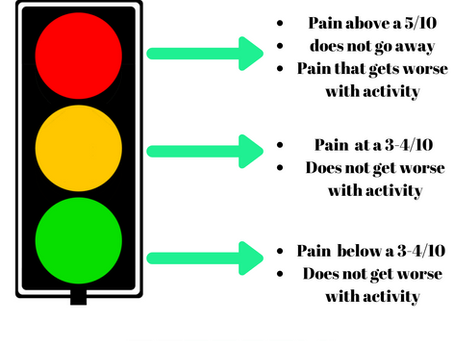Traffic lights have a lot to do with how we teach out athletes to deal with shoulder pain.
You just ended up with shoulder pain so now what? That means you should just completely stop working out and rest for a few weeks right?
Or should you just keep pushing through the pain and hope it gets better? Both of these options have consequences and we should definitely meet somewhere in the middle. Doing too little will set you up for the pain to come back as you get into activity but doing to much will not allow the pain to heal up.
This is where our traffic light comes into play. We use this all the time with our patients and can be a huge tool to know when to push and when to take it easy.

When thinking about pain we typically use a scale of 0-10. 0 Being no pain and 10 being something insane. When thinking about that scale you can use this traffic light approach to determine if we should carry on or not.
· Red lights are an absolute ground to stop this will make things worse.
· Yellow lights are a caution. We can hang out here a little bit but if we hang tight too light it could irritate things so tread lightly.
· Green light this is pain that may start as a yellow light and gets better as we go. In the early stages of pain this needs to be the bread and butter for you so that you can get pain down and get back to activity as quickly as possible.
Now that we have a pretty good understanding of pain its critical that we tackle the most important areas so that you can get the most bang for your buck when working through shoulder pain.
Everyone seems to think that they have a mobility limitation. However this is just not the case. Its important for you to understand do I truly have a mobility limitation or do I have a more of a control/ stability issue.
One of the easiest ways to assess your overhead motion is how easily can I get my arms overhead using the seated shoulder Flexion Test.
Seated Shoulder Flexion Test
Make sure your back is flat against the wall. Grab a PVC and with your palms facing towards you so that we can place the lats on full stretch. Can you get your arms all the way to the wall.
If you cannot you may truly have a mobility Limitation.
Mobility limitations can be caused by a couple different areas but two of the biggest areas we see in our athletes it from the Lats as well as well as this Thoracic spine or the Mid back.

The Latissimus Dorsi(Lats) are a massive group of muscles. They originate on the low back and move all the way up to the top of the arm. Due to the shear volume of pulling we see in our barbell athletes ( Pull ups, Deadlifts, Power Cleans, Rowing, Etc) these muscles by design will get stronger and often times can limit overhead mobility and cause all sorts of issues.
This is why its important to get that tissue loosened up and help keep it moving. Here is a simple way to help release that tissue.
The other problem area is our thoracic spine or our mid back. This is the area from the base of the neck all the way down to the junction of our low back. Very seldom do athletes with shoulder pain work this area and it can be huge for improving mobility. Ive manually released a patients thoracic spine before and watched their shoulder pain completely disappear despite not even touching their shoulder.

We sit around all day and its rare that we ever spend time unlocking this area. Here is a simple way to do it.
Stability Issues
Now if you passed the shoulder flexion test but you are struggling with shoulder pain you could be struggling with shoulder stability issues. The shoulder is an extremely mobile joint by design and oftentimes when we get into kipping work on the rig or Olympic lifting or barbell lifting overhead this extreme mobility can cause problems for athletes.
This is why its important to hammer stability of the shoulder joint and challenge our rotator cuff. One of my favorite drills to accomplish this is the bottoms up KB press.
This one checks all the boxes. The bottoms ups variation of the KB requires the rotator cuff to respond to the unstable nature of the KB. I also love this drill because it requires crazy endurance of the rotator cuff. I find some really strong athletes struggle with this drill.
TO SUMMARIZE: Pain does not automatically mean stop training, but it also does not mean blow through it either. Shoulder pain can be caused by mobility limitations but equally as common as mobility limitations is athletes who lack shoulder stability.


